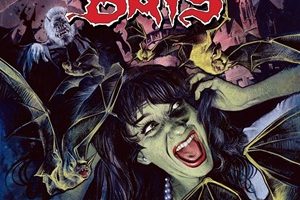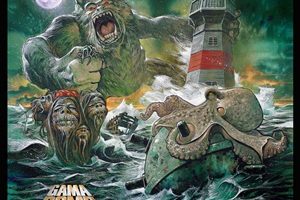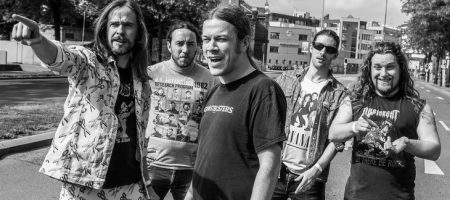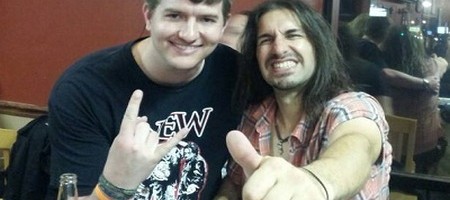Gama Bomb – Stirring the Savage Seas
Sunday, 27th December 2020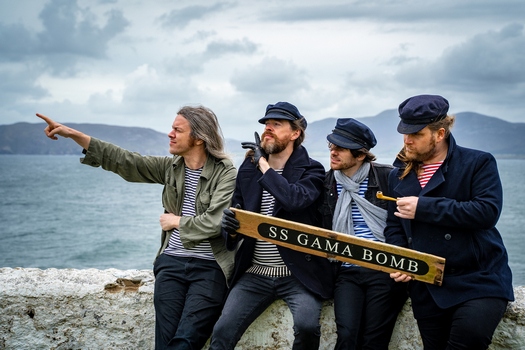
Irish thrash band Gama Bomb keep kicking rear ends and also having fun doing it on their seventh studio album Sea Savage. Now aligning to Prosthetic Records, they have not wavered in their intensity and catchy approach to the genre – incorporating more classic metal influences into the mix. Thanks to Skype we were able to probe the minds of vocalist Philly Byrne, bassist Joe McGuigan and guitarist Domo Dixon, where we shall learn more about the latest label deal, details of the nautical/ horror themes for the new record, the video shoots especially for the on location sequences of the title track – plus discussion of their early years and possibilities for a movie down the line.
Dead Rhetoric: After finishing your deal with AFM Records, you are now on Prosthetic Records. What are your feelings so far about your new label, and were you satisfied overall with how AFM treated you over the last three records?
Philly Byrne: Yes, in the past we’ve had label relationships that were quite fractious, even on a personal level let alone a business level. I think AFM was an amazing tonic to that, they were the chilled out relationship that we needed and had much more of a European sensibility about things. They were very positive, it was warm and friendly. They have a lot of different acts on their label and I’m not sure that we were the highest seller or priority. They did a lot of things for us that we hadn’t done previously, like music videos. It was a good period and kind of a time that we needed to have unlike previous labels we had, they were less interested in having a controlling stake in the band. They allowed us to make the music, they sold the music, and I think that was a very good vibe at the time. It was quite an organic end to that.
The relationship to Prosthetic started on Twitter, oddly enough. I saw a guy respond to one of our tweets and it was EJ who owned the label. We started chatting, made friends, and he had been a fan of the band since the start of the band. That was great for us, we knew Prosthetic’s reputation and EJ has a fantastic reputation as a manager outside of the label. It was great in that sense, building that bridge there. He wants to look out for us, and that feels much more sustainable, fingers crossed, especially after the way the record had to work out.
Joe McGuigan: We are not like a brand new thrash band anymore – there are bands like Crisix and others after us. This is album number seven, and a lot of our heroes from the 80’s didn’t get to number seven. We feel like the elder statesmen of the younger dudes. We are not in the phase of going out and doing 170 shows every time we do a record, we are not in our early thirties anymore. There’s no pot of gold at the end of the rainbow, we do this because we want to do this on our terms.
Byrne: This record was made on our terms more than any other album ever before. It’ll be toured on those terms too. We don’t know what we’ve got in terms of touring because of this virus. On the other side of this, when we get a couple of pints of vaccine in us, it’ll be a great day to get back on the road.
Dead Rhetoric: Do you enjoy the fact that Prosthetic has such a diverse roster as well, and they don’t pigeonhole themselves into just working with thrash bands?
Byrne: Yes, that’s a massive thing. Other labels that our friends are signed to, they will kind of collect bands and you may be one of five thrash bands on their roster.
McGuigan: If you are on the same label as Exodus or something, you are much less important than Exodus so you are going to be on the bottom of the food chain. It is nice to be one of the few or only thrash bands on the label. On AFM, they had a lot more legacy bands, and the good thing about Gama Bomb fans is a lot of them have kind of grown up with us. We had a lot of twenty year olds listening to us, or were twenty when they started and are now thirty and still listening to us. It’s good to be on a label that can capitalize on a younger fanbase with younger bands.
Byrne: To Joe’s point, at least we are not a menagerie kind of thing. I am still discovering bands who are on Prosthetic all the time. They’ve got Venom Prison, they’ve got Vile Creature, they’ve got everything. It’s great to be in the middle of this huge, diverse bunch of bands. Their history, they’ve been there to build some seriously important metal bands. It’s really cool, I feel super positive about the label where we are on. We feel like they behave in a way where they are genuinely interested in the artist’s interests, we are all in the same page trying to sell this music.
Dead Rhetoric: Sea Savage is the latest Gama Bomb record – inspired by Victorian horror, nautical adventures, and songs relating to 80’s and 90’s movies. How did the lyrical content evolve – and where do you see the differences musically or in terms of production and tones compared to the previous records?
Byrne: Joe has always had an interest in ships and U-boats, naval things and nautical wars, that kind of thing. He’s always been into boats, but over the last year or two is when we’ve become obsessed with maritime stuff, haven’t we?
McGuigan: We ended up on the same page with a lot of stuff, we have interests in the ships that went to look for the Northern Passage. Philly and I are big fans of mysterious adventures with ships. That all fed into it. It was one of those concept albums like Powerslave, you want to have songs about the concept on the record and then not. There’s a lot more metal stuff on this record. We used to have a lot of songs on previous records where every song would be about the Ghostbusters or whatever. There is a bit less of that, and a bit more Dio-type lyrics.
As far as differences, our drummer Paul after fifteen years left the band following our tour of Japan. That was a big difference, and we had James Stewart from Vader and he’s a friend of ours, played on the album. He gave things a different flavor.
Byrne: Lyrically as well, a year or two ago I read Moby Dick for the first time. That made a huge impact on me, making a maritime theme. Then other things swirled all around me, a friend of mine because I love short horror stories recommended the short stories of William Hope Hodgson, the British short story writer who died in World War I. A lot of his stories, are maritime mysteries and horror stories. Those kind of things called us together.
Back when we made the album Tales from the Grave in Space, one of the titles we had for the album was almost called Ghost Ship and Arctic Mysteries. We were already thinking of this years ago, it was an ongoing theme. As far as the sound, James brought a more technical aspect and aggressive thing. Paul our old drummer would play quite minimal things, whereas James is much more mechanical and suits our songwriting. Domo our guitarist producing the album was a massive part of it too. You are working with a different canvas when you have a different producer, it’s the first time we’ve worked with a different producer in the last five albums.
McGuigan: We made the last five albums with Scott (Atkins), and we wanted to make this one with him as well. There was a feeling though when we signed with Prosthetic that we needed to try somebody else. Sometimes when we were on AFM we felt like, ‘does anybody at the label listen to Gama Bomb?’. We are working with people now that are all super enthusiastic about us.
Byrne: As Joe said, there is more metal songwriting on this as well. There is a lot more of that operatic singing on it- more of that Dio voice and Halford voice that we did a little bit on the last album. We mix it up a lot as we had a lot of practice time and demoed extensively. I was able to nail a lot of the vocals in advance, and the same with the songwriting. It’s a different record. Powerslave was the reference. We wanted a concept album that you didn’t have to be a slave to. Even the best concept albums, by song eleven does it still have to be about time-travel? (laughs). We don’t have the attention span to do that. It hangs together loosely.
Dead Rhetoric: You reunited with artist Graham Humphreys who did The Terror Tapes and Untouchable Glory cover art for the band previously. Discuss the vibrant illustration on the cover, as it definitely has that throwback quality against its movie poster vibe?
McGuigan: We are huge fans of Graham. We discovered him as kids going into the video shops and the VHS covers for Nightmare on Elm Street and the Evil Dead, we grew up with his artwork. When we first got to work with him, we were really blown away. Graham is the only thing that is going to remain from the old records. He’s the only member of the old cast. In typical Gama Bomb fashion – we did this on the last record too – we’ll go and spend our art budget on something that we end up unhappy with. Oh no – what are we going to do. On the last record Speed Between the Lines, my brother is the designer for the band – he saved our bacon. We had a pretty awful cover, and we commissioned a second cover we weren’t happy with. So my brother did a fixer upper kind of job with that second cover. On this time around we did the same thing – we hired another artist and we weren’t happy with the finished piece. We needed to go back to someone we know that can really smash it out of the park. We didn’t want to end up with something that was an awesome can of soup that had no ‘flavor’ on the outside (laughs).
Byrne: As with many of these things, the old partnership works. When we have worked with others, they don’t get what we mean, and we don’t know what we mean. We will have a jumble of ideas and visuals, and the proper partner will make it into something unique. Graham is good at that. We had certain motifs we wanted to use, a list of objects. Snowy had a couple of jobs to do, he had to represent a new look for him, include this crazy list of things. To Graham that’s nothing. He’s a savant for horror art. I’ve been friends with Graham now for a couple of years, we used to hang out in London. I called him to brief him on the record, and it was a coincidence the themes that came together. I was telling him about this painting The Wrath of the Medusa, all the shipwrecked sailors, he said it was his favorite painting. We took the light from that, and he loves maritime horror. In a Spinal Tap way, we were into the same stuff and it all fell in together. The art came out amazingly, the colors as well.
Domo Dixon: It felt great to have Graham Humphreys back. He’s so good.
Byrne: Having a signature artist is such a cool thing – and it’s never really done anymore. That consistency. When we started the band, the absolute dream of dreams would have been to have Ed Repka – but we have our own Ed now, with no blunt political allegories now. As soon people see the album art, they know there’s a sense of homecoming.
Dead Rhetoric: You choose to release videos for the title track and “Sheer Khan” – is it an easy or difficult process to pick which singles to shoot videos for given the many choices album to album? Also tell us how the treatments evolved for both, as they are highly entertaining once again especially with the silent, black and white older elements to “Sea Savage”?
McGuigan: It’s usually best left (the choices) up to the label. We aren’t able to see the forest from the trees, we are too close to the songs. It is better to get another opinion.
Dixon: We just had to decide what three or four songs were going to be the best songs.
Byrne: They picked “Sea Savage” and “Sheer Khan” – we believe it had it’s own thing. In terms of ideas for videos, it all really comes down to “Sea Savage” we talked about the lighthouse thing as a reference point.
McGuigan: We knew it was going to be nautical-themed. It’s weird, things that people would have a brief discussion about we argued about for months. How black and white should it be, what century it should be set in.
Byrne: Is it a modern representation of a black and white period, or period footage? There are a lot of moving parts to think about – especially in that video. I think it was the most ambitious video that we’ve ever made, it had quite a bit of a plot, it had this overarching period going on. Over 120 shots. The lads had a laugh, and I took the ball and run away with these things. I learned a lot about making a video from the last video we did “ Bring Out the Monster”. There’s a lot of work behind the scenes – you have to have a shot list, you have to scout locations, we were working with Ireland’s lighthouse authority to get access to a lighthouse. We have the monster, people making props, everybody was doing this during lockdown. When lockdown was over, we could sprint straight out and finish this in September. Going up to the top of the lighthouse was amazing. We were up in this ten meter tall lighthouse.
Dixon: If you look at the video you look at how tidy everyone is. You got to see how white our knuckles were. I was incredibly scared with the tightness going up the stairs, come back down, and go up again. I was so happy when it was over, I felt a little bit drunk when we were done. Between the dopamine and endorphins my brain was like no more danger.
Dead Rhetoric: Do you believe it was harder to establish yourselves in the speed/thrash scene or to maintain a certain level of acceptance and popularity as the band grows older?
Byrne: There was no thrash scene. It wasn’t hard because it didn’t exist.
McGuigan: Punk bands took us under their scene.
Byrne: We used to go into the rock and punk pubs and walk around with our first demo on CD in these plastic sleeves and you would have to explain to people first what thrash metal was to get to the band. I would say, ‘do you like Metallica, Anthrax, Megadeth, Nuclear Assault, S.O.D., Slayer?’ The faster you could say it, the funnier we would sound. If they said yes, we would say buy our demo, it’s a quid. They would buy it.
McGuigan: When we first went to London in 2005, it was the first time we were surprised there were other bands who liked thrash. The internet back then, it hadn’t connected people with these old albums yet. We were there before, and it’s got big, and we are still here after that demise.
Byrne: No album will ever be deleted again. Nearly all music exists in this one space, a kid can now go out and like everything. It’s time to stop talking about the thrash revival – the thrash scene will never die.
Dead Rhetoric: Tell us about the “Living for the Lockdown” single and video that you released in May in support of the Dublin Simon Community – where you help bring some levity to a tough time worldwide with this pandemic?
McGuigan: I guess that song had been around for a couple of years. It was a b-side from Untouchable Glory that didn’t end up getting used. We had a spare song sitting around. We asked our ex-drummer Paul if he would mind if we used his drumming, and reconfigure it. We knew we were going to make a record, and test the waters that it would work okay and stop us from all going mad.
Dixon: That was a huge aspect of it, the timing factor. We were going to record something where nobody was in the same room together. It was so difficult, we didn’t know if we could pull this together. This was a no pressure sort of scenario, and then we could see if we could record an album like this. Ironically, it didn’t really indicate how difficult recording the album was going to be, because it was really difficult.
McGuigan: We definitely learned a lot, in that sense. Doing the video, it was Philly’s idea to do this for the Simon community. There was a bit of hesitation to have this as a distraction from the album, but Philly got it together fairly quickly.
Byrne: It came to my attention because the Dublin Simon Community had done a series of live, online gigs. A friend of ours Connor had done a gig, and when I did my homework they were doing amazing work when COVID hit. They were looking after people that were being affected worse than everybody. Lack of provision for people coming into the country, addiction issues, and they do an amazing job helping there. They were out on the streets every night, helping the homeless, giving people food and a toothbrush. They did this all in like two days. We are a niche thrash metal band – we made some money for them. That’s the main thing. I have an idea for my next thrash metal charity project, but it will probably take another year or two to get to completion. It was very fulfilling, it’s good to do some good. We got to flex our muscles and play a bit of music.
Dead Rhetoric: You had some impressive festival appearances last year, including Wacken Open Air and the Japanese Assault Fest – what can you tell us about those gigs, the response, and your overall impressions of Gama Bomb live be it a small club gig up to those festival crowds?
Byrne: We haven’t gigged as much over the last few years – life, the band, children and stuff. Those gigs last year, that was a dream. They were super duper, worth doing. Wacken, the reaction was amazing. Some things went wrong on the day, generally we did really well. I remember at the end of the set dropping to my knees on the end of the monitors, I couldn’t stand up I was so exhausted from screaming my face off. We left it all on the field. We had a really good laugh at Wacken. Japan was amazing, the gigs of a lifetime.
Dixon: We had played a lot of big festivals before, but Japan was new. That was the newest thing we had done in a decade. It was absolutely amazing.
Byrne: Japan was the experience of a lifetime, playing that show. It was like being on mad drugs. My body felt like it was vibrating, being astonished by the crowd. We have never been the band with the biggest stage show, we have some punk DNA in us and we bring a lot of our personality to the gigs. We talk, and we are a bit of a mess sometimes. That’s something that’s a positive, it makes us different on bills from other bands, we’ve been a support band that’s won people over. We introduce ourselves to the audience. There is no other way of doing it.
Dead Rhetoric: How do you see the next twelve to eighteen months shaping up for Gama Bomb in terms of promotion, shows, tours, behind the scenes activities, etc.? Would you ever consider the possibility of developing your own movie down the line, based on your love of them as a band?
Byrne: Well, well, well.
McGuigan: Every time we deal with a new record company, we keep hoping that we can convince them to make a movie. Basically, the last four or five years, we didn’t know anything about making films. Now that we’ve made more videos, we are getting a lot more professional. We have a ways to go yet. I’d love to do this at some point.
Dixon: Every now and again it comes up, and what ends up happening is two people are like, ‘come on- let’s make a film’. And then a different group eight months later says the same thing. When we do a film, that will probably be the end of Gama Bomb (laughs).
McGuigan: We’ll end up doing a movie like The Warriors. And get other thrash bands to play other gangs. Or make a film where every ten minutes there is a thrash song – sort of like a musical.
Byrne: We are frighteningly approaching the place where we can do it. We have other people who work with props, we have access to lighting and video structure. I think in the next two or three years we will start that. With our kind of scale, it would take about three years to make that kind of film. It’s going to take a long time to do. My wife will dread it, but I’d like to do this.












